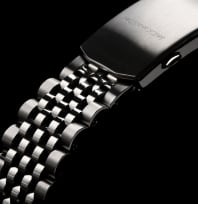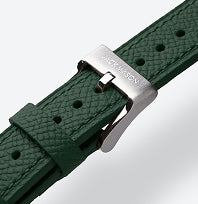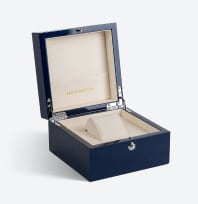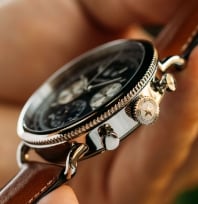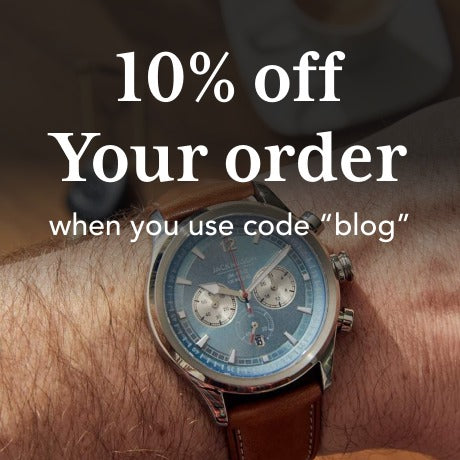Is Your Watch Too Loose On Your Wrist?
Metal watch bands are elegant and versatile, pairing well with a wide array of types of watches. Metal accessories can complement many outfits, and stainless steel is one of the best options out there for your watch band.
Metal watch straps are typically made from a combination of small, interconnected links. These links are held together by tiny pins. The pins bridge the length of each link, fastening one link to the next. The connection between two links in a metal watch band is similar to the link between two pieces in a typical toilet paper holder. One link locks into the next by sliding into a divet in one side of the link beside it – think of one link as the toilet paper and the other as the holder. The pin is the rod that locks the toilet paper to the holder.
Although there are many perks to choosing a metal band for your watch, one important consideration to make is sizing. Unlike leather watch bands, metal straps are usually not adjustable. This means that if your metal strap is too loose or too tight, you will need to add or remove links from it to get the right fit.
How Big Of An Adjustment?
Removing links from your metal watch band is typically an easier task to complete than adding new ones. Additional links may be included with your metal strap, but if not, you will need to order new ones from your strap manufacturer. When your watch strap is too loose, you simply need to shorten the band by removing a few links in the chain.
When it comes to resizing your watch band, you need some key information before you get started. First, you’ll need to determine how many links you need to add or remove to your watch’s metal strap. The best way to make this assessment is to try on your watch. If your watch strap is too loose, you will need to remove a certain amount of links to get a better fit. If it is too tight, you will need to add additional links.
If your watch strap is fitting too loosely, you can determine how many links to remove by fastening the clasp and then using your fingers to pinch your strap tight. Any excess links will then be visible outside of the section of the strap that you have pinched.
Even when you have a relatively clear assessment of how many links you need to remove from your watch band, it is best to take the process slowly. Removing too many links will leave you with a fit that is too tight, requiring you to go backwards in the process. Remove one link at a time, testing out your watch to see how it fits with each adjustment you make.
Once you’ve determined how big of an adjustment you need to make to your watch, you’re ready to get started. Below is a simple list of steps to follow for shortening your metal watch band.
Step One: Clear Your Workspace
Anytime you do any routine maintenance on your watch, or even when you are giving it a quick cleanup, working in a clean, clear, well-lit workspace is a must. Watches are delicate, intricate, and full of small parts that can easily be lost if you are not paying attention to where they are. It is always worth it to take the extra effort to set up a workbench or similar surface to use as your dedicated watch maintenance zone.
One of the most essential components for an ideal watch-maintaining workspace is a high-powered, direct source of light. If you have a desk lamp that can pivot and tilt to various angles, that’s the ideal light source for watch maintenance. Removing links from a metal watch band is a process that involves plenty of small parts, and a well-lit workspace ensures that none of the key components of your watch band are liable to go missing.
Before you move on, examine your workspace to make sure it is comfortable to work in. Shortening your watch band can take some time, and you want to make it as frustration-free of a task as possible. Make sure you have a comfortable chair to work from or a solid space to stand in if you prefer working on your feet. Watch maintenance can be an enjoyable ritual if you prepare for it well, taking care to maximize the workability of your space.
Step Two: Gather Your Tools
To remove links from your metal watch band, you need a few essential tools. First, grab a pushpin. The links in a metal watch band are connected by tiny pins, and you can use a pushpin to loosen the pins enough to pull them out.
Next, you’ll need a pair of needle-nosed pliers. These pliers will serve the purpose of removing the pins from your watch band’s links after they have been loosened using a pushpin. Needle-nosed pliers have flat, non-serrated clamps that make them ideal for handling small objects like the pins in your watch band.
After you have removed links from your watch band to get a better fit, you will need a tool to reconnect the segments of your watch band to each other. This is where a hammer comes in. A standard-sized hammer is a bit too big and unwieldy to get the job done, and using one runs the risk of inadvertently damaging your watch.
Instead of using a full-sized hammer, opt for a smaller, lighter jewelry hammer. Jewelry hammers are designed to make small adjustments to the tiniest components of bracelets, watches, and other wearable accessories with maximum precision.
Step Three: Remove Your Strap
Before you start removing links from your watch strap, you will need to remove the strap from your watch. The strap should include a small lever on each side to uncouple the strap from the left and right sides of your watch. By pressing these levers, your watch strap will separate from the watch.
Set your watch aside in a safe spot for the rest of the process. Lay the watch strap on its side so that the pins are pointing up at you. You can reposition the strap as needed, but starting at this angle gives you an ideal vantage point to see what you are working with.
Step Four: Loosen the Pin
Take your pushpin and gently press it into the connecting point between two links in your strap. Each of these points houses a pin, which will pop out the opposite side of the link when pressed. Your pushpin will not fully remove the pin from the link – you’ll finish the job in a moment with pliers.
Step Four: Remove The Pin
Once a pin has been partially removed, take the pliers and gently separate it from the links. Without a pin, two links will uncouple from each other, shortening the watch band. After you have removed a pin, test the fit of your watch. If it is still too loose, you will need to remove additional pins.
For each pin you remove, test out the fit of your watch. A fit that is too tight means you need to replace some of the pins to get your band loose enough again. Remember, this is a process that is better to take slow – overly aggressive adjustments will leave you frustrated and with a band that is too tight to wear.
Step Five: Reconnect The Band
After you have removed the number of links you needed to get rid of to achieve an ideal fit, it’s time to put your band back together. At this point in the process, you are dealing with two separate pieces of your watch band, disconnected where the links you removed once were. These two pieces will need to be rejoined to put your watch back on.
To reconnect the separate pieces of your watch, take one of the pins you have removed and use your fingers to press into the two disconnected links on the ends of the sections of your straps. The pin should slide partially into the links without too much pressure.
Once the pin is in the links, use your jewelry hammer to gently tap it into place. The gentle pressure from the hammer should be enough to securely reposition the pin, fastening the two sections of your strap together.
When your strap is resized and fully intact, reconnect it to your watch and perform a final fitting test. If you removed the right amount of links from your strap, you should get a comfortable, not-too-loose, not-too-tight fit. Wearing a metal watch strap that fits perfectly feels elegant and luxurious, allowing you to feel the weight of the metal without it suffocating your wrist or sitting too loosely. The ideal fit can take your watch-wearing experience to the next level.
Sources:
https://watchdig.org/blog/leather-vs-metal-strap-watches/


